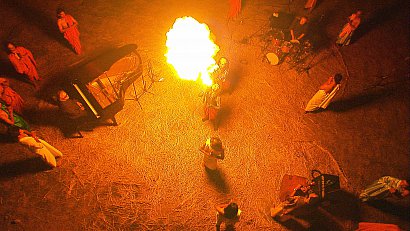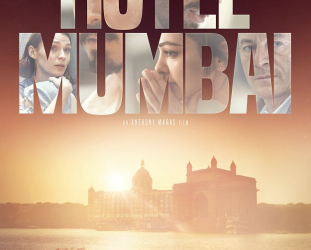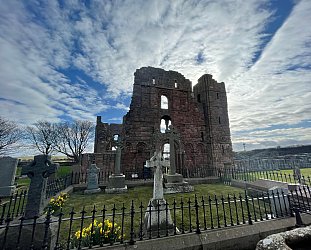Graham Reid | | 3 min read

On the face of it, there would seem little common ground between European free jazz and the traditional music and Buddhist culture of Java. But for Aucklander Winston Marsh -- co-producer of the film Teak Leaves at the Temples the intersection is in the immediacy and “the sense of the now” in the jazz and the transience of life and appreciation of the moment that Buddhist philosophy teaches.
And certainly the Javanese people and musicians in Teak Leaves at the Temples seem to have fewer problems with the churning piano of Guerino Mazzola, hard percussion of Heinz Geisser and fluid bass of Norris Jones (aka Sirone) than perhaps many Western audiences might.
Although free jazz is grounded in individual expression and Javanese traditional music in the collective, the faces of the Javanese people are illuminated by the resulting music, especially when their local musicians play alongside this jazz trio.
Teak Leaves at the Temples is more than just a musical encounter however because in the hands of famed Indonesian director Garin Nugroho there is an understated and often un-stated narrative exploring social and political comment, the relationship between sculpture and dance and song, and Buddhist philosophy in this predominantly Muslim region.
“What was also interesting,” says Marsh “is that we tend to
think that Muslims are inward looking but the people are not.”
He tells of
the film crews being welcomed in villages, and of how open the local people were
to this unusual and unexpected meeting of cultures and musical
styles.
If the common ground is in the realm of the esoteric -- and free jazz is certainly that -- it is surprising how much commonality these very different musical cultures find: in the driving percussion of local musicians and Mazzola’s oceanic sweeps across the keyboard there is a similar energy. And, when the trio join up with the popular Indonesian jazz-fusion group the Sono Seni Ensemble, bassist Sirone finds a counterpoint in the keening vocals of that group’s woman singer.
At that point those who remember Sirone as the bassist in New York’s famous Revolutionary Ensemble of the 70s will hear him play off the singer in much the same manner he used to do with the Revolutionary Ensemble’s violinist Leroy Jenkins. The chasm between East and West is bridged through this thrilling music.
But Teak Leaves in the Temples -- deftly layered and non-linear, much like free jazz -- is also book-ended by a young woman dancer who suggests the transience of life by crushing dried teak leaves and scattering them to the wind, and also introduces a remarkable character: the stone carver who dresses like Superman. (He gives his reasons and they make weird sense).
“The way the free jazz music is allowed [director] Nugroho to be able to cut to the village life and to temple sculpture and pull the film together like a collage,” says Marsh who first came to the project when he saw Mazzola and Geisser play in a temple complex in Jogjakarta in 2004.
Invited by his co-producer Toni Hauswirth to see a concert by the duo, he was immediately struck by how free jazz had great potential as a link with the music and culture of the region.
“I’d heard the duos recordings and was interested in how one might make free jazz more appealing, and I had been working on the interplay between visual art and literature. I thought probably rather than make a concert movie it would be better to have something that incorporated the music and performance with cuts to the very colourful life in Java.”
It was Marsh’s suggestion to bring in a bass player, and although they spoke with Swiss and European directors -- “they wanted to make it as a linear documentary and build up to a concert, very much an accepted format” -- when Nugroho indicated he was interested the project started in earnest.
When the jazz trio arrived in Indonesia in 2007, with sponsorship from Indonesian sources, the film began to take shape by incorporating ideas from Nugroho and Mazzola -- albeit in a rather loose but surprisingly focused manner.
“Nugroho presented it in a very Asian way and as documentary it is not in the Western style at all, very much an Asian thought process. No one knew exactly what he had in mind for the concerts. When I arrived in Borubudur on the morning a concert all of these trucks turned up with literally hundreds of people. Nugroho had spoken to a number of these villagers and these people all just turned up in their costumes in the village trucks and the set was built and they performed. And it was all improvised.
“It was a revelation not knowing what was planned -- and then he said they were short on shooting time and I had no idea what he meant. I went out to various sites with him and he just shot performers and participants, and he just didn’t worry about rehearsals. So there was a lot of spontaneity -- and that went well with the free jazz.”
Already Teak Leaves at the Temples has been building a good film festival pedigree -- Rotterdam, Sydney, Singapore, Auckland, Busan and Vancouver -- although it has yet to have major screenings in Indonesia.
But given the enthusiasm shown by the audiences and village people at the concerts -- which are beautifully filmed in temples, fields and villages -- it will find an audience there too.
So free jazz and Javanese traditional music together?
Not so unusual after all.





post a comment